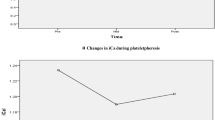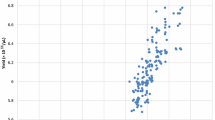Abstract
Background
Platelet Rich Plasma-Platelet concentrate (PRP-PC), Buffy Coat poor-platelet concentrate (BCPC), and Apheresis — PC were prepared and their therapeutic efficacy were assessed in thrombocytopenic patients.
Study design and methods
PRP-PC and BC-PC were prepared from whole blood and Apheresis-PC by automated cell separator. The post transfusion efficacy of transfused platelets was assessed at 1 hour and 20 hours by corrected count increment (CCI) and percentage recovery (PR).
Results
A total of 60 patients’ (20 each for PRP-PC, BC-PC and Apheresis-PC) were enrolled in this study. Forty one patients received therapeutic and nineteen received prophylactic transfusion support. Patients with aplastic anemia 43% (25/60) and acute leukemia 38% (23/60) formed a majority of study population. Platelet dosage of patients’ received PRP-PC, BC-PC and apheresis-PC were 2.4±0.82 × 1011 (mean±SD), 2.2±0.83 × 1011 (mean±SD) and 4.14±1.82 × 1011 (mean±SD) and ranged from 1.16–4.11 × 1011, 1.04−4.20 × 1011 and 1.22−8.90 × 1011 respectively. There was significantly increase in inter-transfusion interval with Apheresis-PC than with PRP-PC and BC-PC recipients [(Mean±S.D.), 4.7±1.33 days Vs 2.7±0.82 days Vs 2.5±0.7 days respectively] (p < 0.05).
Conclusions
Patients transfused with apheresis-PC had received higher platelet dosage than PRP-PC and BC-PC and this difference was statistically significant (p < 0.001). The post transfusion platelet counts and increments at 1 hour and 20 hours were significantly higher with apheresis-PC than PRP-PC and BC-PC (p < 0.001). However, the corrected count increment (CCI) and percentage recovery (PR) in all three groups were comparable. There was significantly increase in inter-transfusion interval with apheresis-PC than PRPPC and BC-PC (p < 0.05).
Similar content being viewed by others
Abbreviations
- RDP:
-
Random donor platelets
- SDP:
-
single donor platelets
- PRP-PC:
-
Platelet Rich Plasma-Platelet concentrate
- BC-PC:
-
Buffy coat poor-platelet concentrate
- PC:
-
platelet concentrate
- CCI:
-
corrected count increment
- PR:
-
percentage recovery.
References
Hersh JK, Hom EG, Brecher ME (1998) Mathematical modeling of platelet survival with implications for optimal transfusion practice in the chronically platelet transfusion-dependent patient. Transfusion 38:637–644
Perrota PL, Anderson KC (2003) Blood banking and trans-fusion medicine — Basic Principles and Practice. Churchill Livingstone, Philadelphia: 181–205
Sniecinski I, O’Donnell MR, Norwicki B, Hill LR (1988) Prevention of refractoriness of HLA-alloimmunization using filtered blood products. Blood 71:1402–1407
Brecher ME, Butch SH, Cathouri AR (2000) Technical Manual: American Association of Blood Bank (AABB), 13th edition. Bethesda, Maryland 346
Mosteller RD (1987) Simplified calculation of body surface area. N Engl J Med 317:1098
Friedberg RC, Donelly SF, Boyd JC, Gray LS, Minz PD (1993) Clinical and blood bank factors in the management of platelet refractoriness and alloimmunization. Blood 81:3128–3134
Herman JH (1999) Transfusion therapy: Clinical principles and practice. AABB Press, Bethesda Maryland, 65–79
Baer MR, Bloomfield CD, Kasprisin DO (1992) Controversies in transfusion medicine; prophylactic platelet transfusion therapy: Pro Transfusion 32:377–380
Consensus conference (1987) Platelet transfusion therapy. JAMA 257:1777–1780
Haker LA, Roskos L, Cheung E (1998) Effective and efficient platelet transfusion strategies that maintain hemostatic protection. Transfusion 38:619–621
O’Connell B, Lee EJ, Schiffer CA (1998) The value of 10 minutes post transfusion platelet counts. Transfusion 28:66–67
Davis KV, Slichter SJ, Coras L (1999) corrected Count Increment and Percentage Platelet Recovery as measures of post transfusion platelet response: Problem and Solution. Transfusion 39:586–592
Norol F, Bierling P, Roudot-Thoroval F et al (1998) Platelet transfusion: a dose-response study. Blood 92: 1448–1453
Klumpp RT, Herman JH, Gaughan JP et al (1999) Clinical consequences of alterations in platelet transfusion dose: A prospective randomized double blind trial. Transfusion 39:674–681
Tinmouth AT, Freedman J (2003) Prophylactic Platelet Transfusions: Which Dose is the Best? A Review of Literature. Tran Med Rev 17:181–193
Author information
Authors and Affiliations
Corresponding author
Rights and permissions
About this article
Cite this article
Singh, R.P., Marwaha, N., Malhotra, P. et al. Therapeutic efficacy of different types of platelet concentrates in thrombocytopenic patients. Indian J Hematol Blood Transfus 24, 16–22 (2008). https://doi.org/10.1007/s12288-008-0024-9
Received:
Accepted:
Published:
Issue Date:
DOI: https://doi.org/10.1007/s12288-008-0024-9




